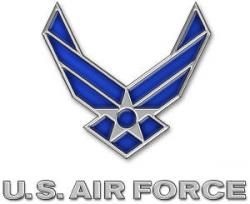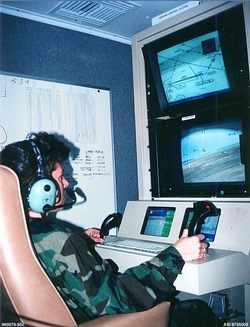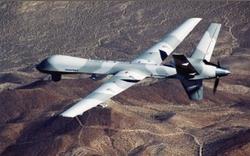UASs Give The Air Force Greater Flexibility, Longer
Missions
 The U.S. military's expanded
overseas use of unmanned aircraft highlights the increased
importance of such aerial platforms to current and future military
operations, senior Air Force officers said in Washington
Thursday.
The U.S. military's expanded
overseas use of unmanned aircraft highlights the increased
importance of such aerial platforms to current and future military
operations, senior Air Force officers said in Washington
Thursday.
The just-released Unmanned Aircraft Systems Flight Plan will
serve as a template for how the Air Force will look in 2047 - the
100th anniversary of the U.S. Air Force -- Gen. William M. Fraser
III, the Air Force's vice chief of staff, told reporters at a
Pentagon news conference.
"The future of our systems is really now," Fraser said. "The Air
Force today looks dramatically different than it did 35 years ago
when I first came aboard on active duty."
The flight plan, he explained, lays out the Air Force's "vision
for maximizing our efforts in unmanned aerial systems" today and in
the future.
"We'll continue to push the UAS envelope," Fraser said, adding
that unmanned systems are unmanned in name only.
 "While there may be no airmen
onboard the actual vehicle, there indeed are airmen involved in
every step of the process," Fraser said, including the pilots who
operate the vehicles' remote controls and sensors and maintenance
personnel.
"While there may be no airmen
onboard the actual vehicle, there indeed are airmen involved in
every step of the process," Fraser said, including the pilots who
operate the vehicles' remote controls and sensors and maintenance
personnel.
Unmanned aircraft systems "represent an important addition to
our comprehensive set of Air Force capabilities that actually
define air power," Fraser said.
Lt. Gen. David A. Deptula, the Air Force's deputy chief of staff
for intelligence, surveillance and reconnaissance, told reporters
that unmanned aircraft systems have proven effective during aerial
strike missions against insurgents in Afghanistan and Pakistan,
while also performing surveillance and intelligence-gathering
missions.
Persistent flight capability, Deptula said, is one of the
advantages of employing unmanned aerial vehicles in military
missions.
"What UASs bring to the table," Deptula explained, "is the
ability to stay in position or maneuver over large areas for a long
period of time - that's where a person in an aircraft becomes a
limitation."
UAS mission success rates have resulted in high demand for the
unmanned aerial platforms, Deptula said, noting that high- and
medium-altitude UAS overseas combat missions have increased more
than 600 percent during the past six years.
"What the Air Force wants to do," Deptula said, "is to get the
most out of these systems to increase our joint warfighting
capability, while promoting service interdependency and the wisest
use of our taxpayer dollars."
 Yet, Deptula said, the flight plan
isn't just about how UASs are employed today, but also about how
unmanned aerial technology could be applied in different mission
realms in order to confront future challenges. For example, he
said, UAS technology could one day be used in a modular platform
that could perform a variety of tasks, such as cargo transport and
aircraft refueling missions.
Yet, Deptula said, the flight plan
isn't just about how UASs are employed today, but also about how
unmanned aerial technology could be applied in different mission
realms in order to confront future challenges. For example, he
said, UAS technology could one day be used in a modular platform
that could perform a variety of tasks, such as cargo transport and
aircraft refueling missions.
Deptula equated today's level of UAS development with the
progress made in manned aircraft in the 1920s.
There's "lots of potential" for expanding UAS technology across
the military in the coming years, Deptula said, but he also pointed
out that replacing conventional fighter planes and pilots with
unmanned aerial vehicles is a long way off.
The flight plan doesn't provide specific solutions, but it does
address "concepts and possibilities that will fill in and morph
over time," said Col. Eric Mathewson, the director of the Air
Force's UAS Task Force.
The plan, Mathewson said, "allows us to reach out and talk to
academia and industry, the other services, [Defense
Department]-wide, our coalition and allied partners, and work
together in a more efficient and synergistic way."
 ANN's Daily Aero-Term (04.14.24): Maximum Authorized Altitude
ANN's Daily Aero-Term (04.14.24): Maximum Authorized Altitude ANN's Daily Aero-Linx (04.14.24)
ANN's Daily Aero-Linx (04.14.24) Classic Aero-TV: 'We're Surviving'-- Kyle Franklin Describes Airshow Life 2013
Classic Aero-TV: 'We're Surviving'-- Kyle Franklin Describes Airshow Life 2013 Aero-News: Quote of the Day (04.14.24)
Aero-News: Quote of the Day (04.14.24) Airborne 04.09.24: SnF24!, Piper-DeltaHawk!, Fisher Update, Junkers
Airborne 04.09.24: SnF24!, Piper-DeltaHawk!, Fisher Update, Junkers





